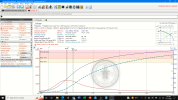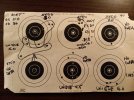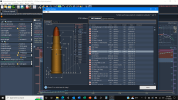The only time velocity causes leading is when the land pressure on the sides of the bullet engraves exceeds the alloy's ability to not melt from surface friction and rub off, causing gas leaks, bullet ablation, and particle deposition in the bore. Harder, lower melt point alloys are worse than high velocity for several reasons, not the least of which is the inability to conform to the barrel at lower pressures near the muzzle.
Low muzzle pressure does not equal better groups any more than a clean-burning powder, low ES/SD, or low velocity does. Some of the best loads I have are dirty, but for sure not all of them. Not all of my clean-burning loads with great chronograph numbers and low muzzle pressure shoot well, in fact not many of them did. The only way to tell in YOUR system is try stuff and see. I'm not saying ignore muzzle pressure or burn %, but don't let it rule your thinking, either.
What I look for in a good model is a gentle pressure rise, enough peak pressure to burn the particular powder well enough (based mostly on my own empirical data of what it takes to get a consistent burn with a given powder in a given cartridge case), good case fill, and how the powder seems to be reacting in the case as I increase or decrease the charge weight in the model. Often I'm looking for the lowest muzzle pressure possible while meeting all my other requirements for the load simply because I use gun mufflers and want to reduce the heat and stress on them to the minimum. NFA items are expensive to repair because only an 07 FFL can legally perform the work. I also own and shoot a lot of gas-operated semi-auto rifles and am interested in port pressure. I've gotten to the point that I can tell if a load will cycle an AR simply by looking at the QL pressure curve and knowing the port size and location...saving me many trials and gas system adjustments in the route to finding a good load that does what I want it to. None of that applies to you in particular, so keep your options open regarding powder choice. 2400 seemed to want to work for you once you got it up to where it started burning better, I'd say 2200 fps is likely the sweet spot for it in your particular rifle/bullet combination. If you can't make it shoot well, try Unique again, just more of it. The CBA guys who shoot the .223 Rem use linotype and Titegroup. If they were using a more malleable alloy and knew how to prepare their brass and fit the bullets to their rifles in a different way than they're used to doing, they'd be having much more consistent results. Titegroup would be a good one for you, too, particularly because it doesn't exhibit the position sensitivity that 2400, Unique, 231, and Bullseye do at low loading densities. Clays is another one that has lower position sensitivity, but also a peakier curve and may require a little bit stiffer alloy than Titegroup would due to throat dynamics and fixed ammunition. If you breech seat, that removes a lot of variables and all you have to do is find a powder that burns consistently at the velocity the system likes and then tune it to match the rifle's harmonics.
There's a huge gap in data in all the loading manuals where the popgun cast bullet loads end and the jacketed bullet loads begin. This is where the thermodynamic models, our own generated chronograph data, and the manual info are all sort of assimilated and compared to get us into the range we want. Cast bullet performance has been sold short by all the big names since the beginning and I feel it is quite a sin. I'm not saying to not stay in the "easy zone" for accuracy loads velocity-wise, but don't think that zone means as low as you can poop a bullet out the muzzle, either.




